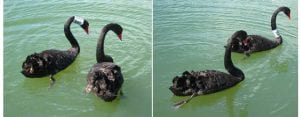-
- Why do some swans have collars?
We are studying the biology and behaviour of these iconic birds. We’re also concerned about the effects of drought on swan populations. The numbered collars help us to track movements of individual birds and monitor their health. They enable us to identify birds from a distance without the need for capture. The collars are made of a lightweight plastic and are custom-manufactured for swans in the United States. We use black collars for males and white collars for females.
Collars also allow members of the public to help us with our study by reporting sightings of Black Swans around Victoria.
- The collars look tight. Aren’t they choking the birds?
No. In winter, or during displays, the birds fluff out their neck feathers, which can give the collar the appearance of being ‘tight’. The neck collars are actually quite a loose fit on the swan’s neck and and are free to slip up and down during normal activities.
- Sometimes the collar sits up behind the head – is this a problem?
No. Swans feed by ‘upending’ – reaching underwater for submerged weeds with their bottoms and feet up in the air. During upending, the collar will sometimes slip down to behind the head and remain there for a minute or two until it slips back down to its normal position at the base of the neck as a result of gravity.
- How can you be sure the collars are safe for black swans?
We evaluated the safety of swan collars very carefully before deciding to fit them to black swans. We recently published the results of a study comparing the behaviour of collared and non-collared black swans (reference below). We found no difference in the proportion of time the birds spent foraging or engaged in other non-foraging behaviours, such as preening. We also compared the weights of collared and non-collared birds, where again there was no difference. At this stage therefore, there is no scientific evidence to suggest that the collars cause the birds distress, injury or other harm.
- Have these procedures been vetted by animal welfare authorities?
Yes. The use of neck collars on the swans has been approved by the Animal Experimentation and Ethics Committee of the University of Melbourne, the Australian Bird and Bat Banding Scheme, the Department of Sustainability and Environment (Victoria), and Parks Victoria. The RSPCA and Wildlife Victoria are also aware of the program and do not consider the collars to be a welfare issue.
- What about long-term effects of the collars?
Neck collars have been extensively trialed and used safely on swans in Europe and North America for more than 50 years. Although most people in Australia are not familiar with animal collars, they have been used as a means of identifying swans in the northern hemisphere on more than 25,000 individuals of several species including Mute, Trumpeter, and Tundra swans.
- Where can I learn more about other studies using neck collars?
The links below will take you to web sites for other studies (primarily in the USA) involving neck collars on swans:
http://www.pwrc.usgs.gov/BBL/homepage/swan.html
http://www.pwrc.usgs.gov/BBL/homepage/aboutaux.htm#neck
http://www.iowadnr.com/wildlife/files/swanreporting.html
http://www.dgif.state.va.us/wildlife/swan/study.html
- Why do some swans have collars?

